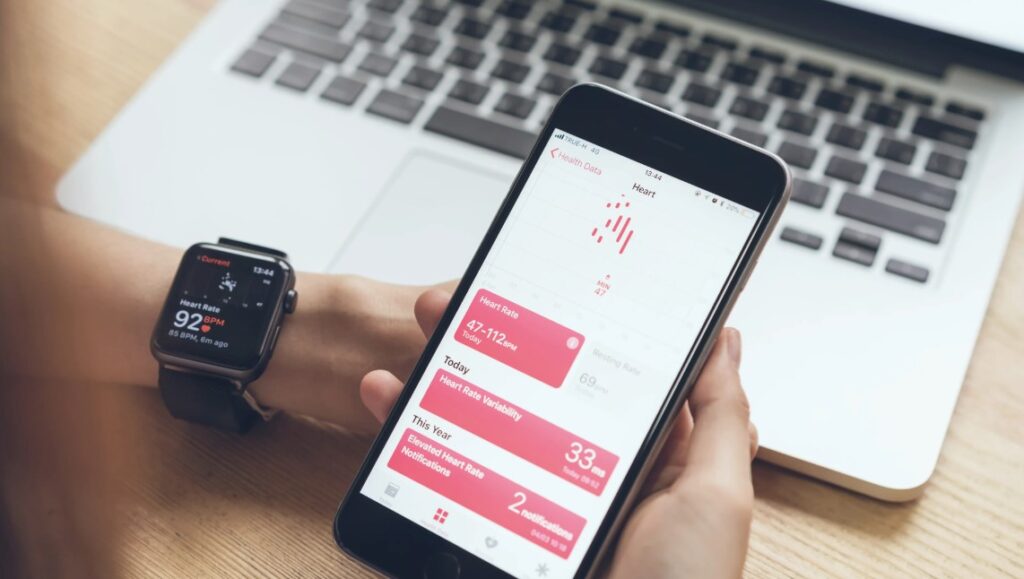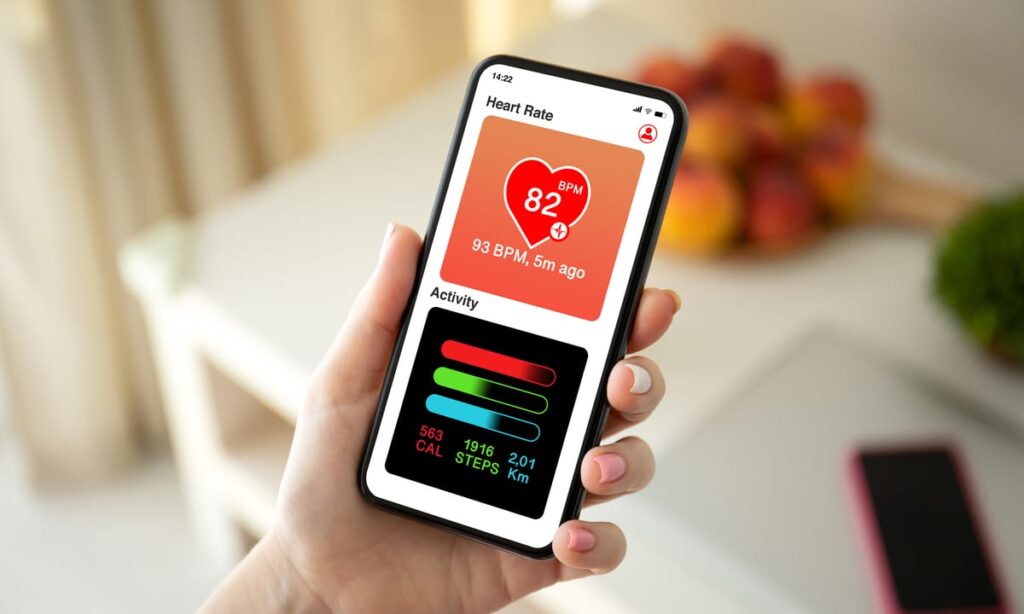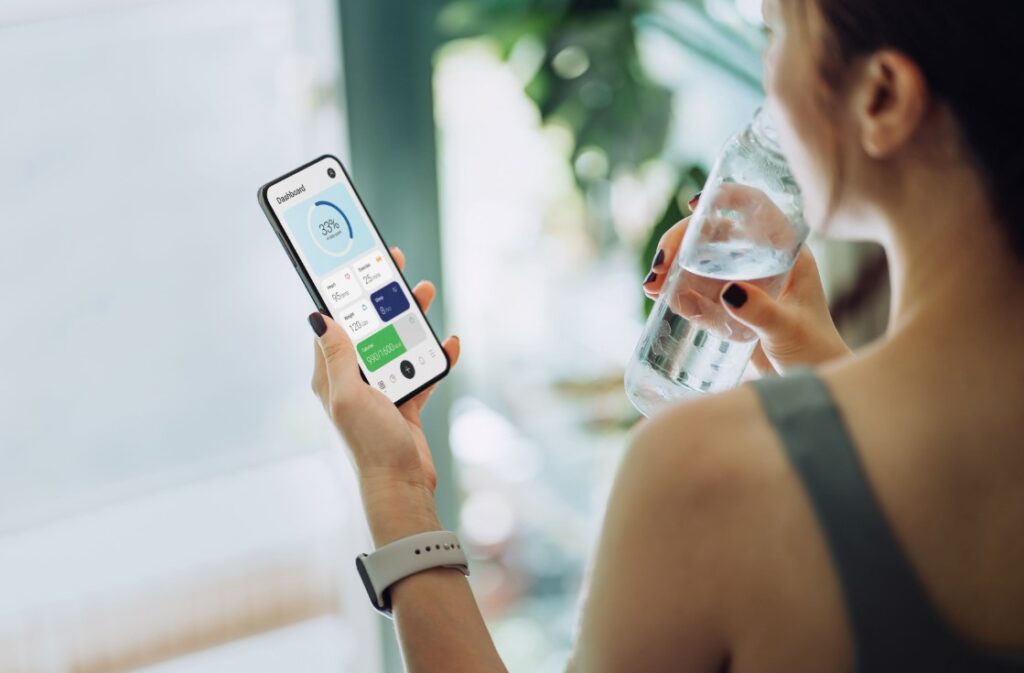A well-being app, also known as a health or wellness app, is a mobile or web application designed to support individuals in taking care of their physical, mental, and emotional health. These apps offer a range of features and tools for tracking and monitoring health, providing guidance and support for healthy behavior, and promoting overall well-being.
Topics covered by wellness apps include fitness, nutrition, mental health, stress management, sleep, mindfulness, and more. They empower individuals to take control of their health by providing convenient and accessible resources that can be used anytime, anywhere.
With the increasing demand for prioritizing health and wellness in busy lives, health apps are gaining popularity and have the potential to positively impact individuals’ overall well-being and quality of life. In this article, we will delve into the topic of well-being app development.
From Simple Beginnings ─ The History of Health Apps

Source: cnn.com
The history of health apps can be traced back to the early days of mobile applications, coinciding with the widespread availability of smartphones. Initially, health apps focused on simple functionalities like step tracking, calorie counting, and basic fitness tracking.
However, with advancements in technology and growing awareness about the importance of health and wellness, the development of health apps has evolved significantly.
Today, health apps have gained immense popularity for several reasons. There is a growing emphasis on preventive healthcare and self-care, with individuals seeking proactive ways to manage their health and well-being.
Health apps provide convenient tools for monitoring various aspects of health, such as fitness levels, nutrition, sleep patterns, mental health, and more. These apps empower users to take control of their health and make informed decisions about their lifestyle choices.
5 The Latest Trends in Building Well-Being Apps
These trends in health app development are shaping the landscape of health and wellness apps, offering innovative ways for individuals to manage their physical, mental, and emotional well-being using mobile and web-based technologies. Take a closer look:
1. Personalization
Well-being apps are leveraging data analytics, artificial intelligence, and machine learning to offer personalized experiences to users. This includes tailoring app content, recommendations, and feedback based on individual health data, goals, and preferences, providing a unique and customized approach to improving well-being.
2. Integration with Wearable Devices
Wellness apps are designed to seamlessly integrate with wearable devices, such as fitness trackers, smartwatches, and other health monitoring devices. This allows users to track their health and wellness data in real time and receive actionable insights through the app, empowering them to make informed decisions about their health.

Source: elpassion.com
3. Gamification
Gamification techniques, such as challenges, rewards, and badges, are incorporated into health apps to make them engaging and motivating for users. Gamification encourages users to adopt healthy behaviors, set and achieve goals, and stay motivated on their well-being journey, making the process enjoyable and rewarding.
4. Mental Health and Mindfulness
Wellness apps are increasingly focusing on mental health and mindfulness, offering features such as meditation exercises, stress management tools, relaxation techniques, and cognitive-behavioral therapy techniques to improve users’ mental well-being. These features provide support for managing stress, anxiety, and other mental health challenges, promoting overall emotional well-being.
5. Sleep Tracking and Sleep Health
Sleep tracking and sleep health features are gaining popularity in such apps, as sleep is recognized as a critical factor in overall health and wellness. Sleep tracking, analysis, and improvement tools can help users optimize their sleep patterns and improve their sleep quality, leading to better physical and mental well-being.
Different Types of Health Apps

Source: pymnts.com
Well-being apps encompass a diverse array of applications aimed at improving various facets of an individual’s physical, mental, and emotional well-being. Common types of wellness apps include:
- Fitness and exercise apps ─ These apps offer guidance, tracking, and motivation for physical activities such as workouts, running, cycling, yoga, and more. They may feature workout plans, exercise tracking, goal setting, and progress tracking.
- Nutrition and diet apps ─ Such apps assist users in managing their diet and nutrition by providing information, tracking tools, meal planning, calorie counting, and personalized recommendations for healthy eating habits.
- Meditation and mindfulness apps ─ They provide guided meditation sessions, relaxation techniques, breathing exercises, and other mindfulness practices to aid users in reducing stress, improving mental clarity, and enhancing emotional well-being.
- Sleep tracking and sleep health apps ─ These apps monitor and analyze users’ sleep patterns to provide insights, recommendations, and tools for enhancing sleep quality, establishing healthy sleep routines, and managing sleep-related issues.
- Mental health and wellness apps ─ They focus on mental health and emotional well-being, offering resources, tools, and support for managing stress, anxiety, depression, and other mental health conditions. They may include features such as mood tracking, journaling, coping strategies, and access to mental health professionals.
- Self-care and wellness apps ─ These apps promote a holistic approach to well-being, incorporating various aspects of physical, mental, and emotional health. They may feature self-care tips, self-reflection exercises, gratitude practices, and stress reduction techniques.
5 Wellness App Must-Have Features

Source: housebeautiful.com
- Social connectivity ─ Apps can incorporate social connectivity features to foster a sense of community and mutual support among users. These features may include social sharing, group challenges, peer support, and online communities where users can connect, share experiences, and motivate each other toward better health and wellness.
- Remote monitoring and telehealth ─ Well-being apps can offer remote monitoring and telehealth functionalities, enabling users to virtually connect with healthcare professionals, monitor chronic conditions, and receive remote health assessments, consultations, and care.
- Customizable goal setting and tracking ─ Wellness apps should empower users to set and track their own health and wellness goals, offering them the flexibility to customize their plans and progress tracking based on their individual needs and preferences.
- Data analytics and AI-powered insights ─ Wellness apps can leverage data analytics and artificial intelligence to provide users with actionable insights and feedback on their health and wellness data. This can assist users in making informed decisions and adjustments to their well-being routines.
- User-friendly interface and navigation ─ Health apps should feature a user-friendly interface and easy navigation, making it intuitive and convenient for users to access and utilize the app’s features. This can enhance the overall usability and accessibility of the app for users of all levels of technological proficiency.
Incorporate these five essential features into your wellness app, while also keeping in mind the trends we discussed earlier. By doing so, you can create a competitive app that is aligned with the latest developments in the wellness industry.
Building a Well-Being App ─ A Step-by-Step Guide

Source: jobstreet.com.my
- Clearly articulate the purpose and goals of your well-being app. Identify the specific aspects of physical, mental, and emotional well-being that your app will focus on, and how it will address the problems faced by users.
- Conduct thorough market research to gain deep insights into the needs, preferences, and pain points of your target audience in relation to well-being. Utilize this information to design features and functionalities that are tailored to meet their requirements.
- Based on your app’s purpose and target audience, strategically plan the features and functionalities you want to incorporate. Consider including essential features such as fitness tracking, nutrition tracking, meditation sessions, sleep tracking, and goal setting, as well as innovative features that set your app apart from competitors.
- Decide on the platforms you will develop your app for, such as iOS, Android, or web-based. Take into account factors such as the platform preferences of your target audience, budget, and development expertise.
- Create a visually appealing and intuitive interface that is easy to navigate and understand. Consider incorporating user experience (UX) principles and design best practices to ensure a seamless and engaging user experience.
- Build the core functionalities of your app, such as fitness tracking, nutrition tracking, meditation sessions, sleep tracking, and goal setting, with a focus on smooth performance, accurate data, and an excellent user experience.
- Ensure the security and privacy of user data by implementing robust security measures, such as encryption, authentication, and data protection protocols. Comply with relevant data privacy regulations, such as GDPR and HIPAA.
- Conduct thorough testing to identify and rectify any bugs, glitches, or performance issues in your app. Gather feedback from beta testers and make necessary improvements to ensure a stable and reliable app.
- Optimize the performance of your app, including its loading speed, responsiveness, and overall efficiency. Ensure it performs well on different devices and network conditions.
- Once your app is ready, launch it on the appropriate app stores or web platforms. Develop a comprehensive marketing and promotion strategy to create awareness and attract users to your app. Consider leveraging various digital marketing techniques, such as social media, content marketing, and influencer partnerships.
How to Monetize the Wellness App

Source: constructionexec.com
It’s crucial to carefully consider a monetization strategy that aligns with your app’s goals, and target audience, while also complying with relevant laws and regulations related to privacy, data protection, and advertising.
- In-App purchases ─ Offer premium features or content that users can unlock through in-app purchases, such as subscription plans, one-time purchases, or virtual goods.
- Advertising ─ Display ads within the app, such as banners, interstitials, or native ads, to generate revenue from advertisers.
- Sponsorships and partnerships ─ Collaborate with relevant brands or organizations for sponsorships or partnerships, where they provide funding or resources in exchange for promotional opportunities within the app.
- Data monetization ─ Collect and analyze user data (with consent) to generate insights or sell to third parties for research or marketing purposes.
- Crowdfunding or donations ─ Encourage users to contribute through crowdfunding campaigns or voluntary donations to support the development and maintenance of the app.
Conclusion
To sum it up, developing a wellness app is a compelling idea. Health apps have gained immense popularity in recent years as people increasingly prioritize their physical, mental, and emotional health. The global wellness industry is experiencing a booming demand for convenient and accessible tools that can aid individuals in enhancing their well-being.
What is more important, well-being apps have the potential to create a positive impact on users’ lives. These apps can offer personalized tools and resources for tracking and improving physical fitness, mental health, sleep patterns, nutrition, and more. By empowering users to take control of their health and well-being, and promoting positive habits and lifestyle changes, well-being apps can lead to an improved quality of life.















